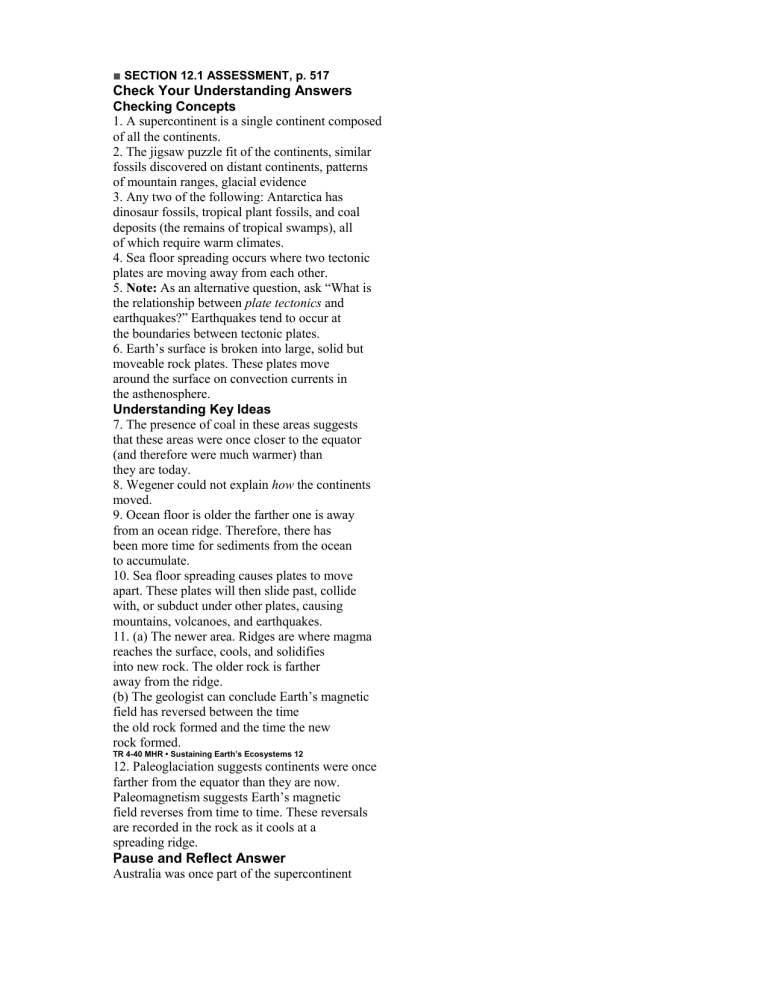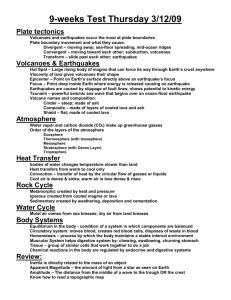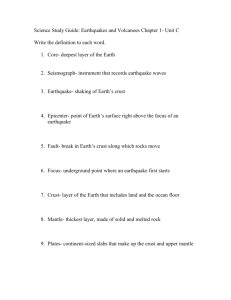Chapter 12 Answers (sc10)

■
SECTION 12.1 ASSESSMENT, p. 517
Check Your Understanding Answers
Checking Concepts
1. A supercontinent is a single continent composed of all the continents.
2. The jigsaw puzzle fit of the continents, similar fossils discovered on distant continents, patterns of mountain ranges, glacial evidence
3. Any two of the following: Antarctica has dinosaur fossils, tropical plant fossils, and coal deposits (the remains of tropical swamps), all of which require warm climates.
4. Sea floor spreading occurs where two tectonic plates are moving away from each other.
5. Note:
As an alternative question, ask “What is the relationship between plate tectonics and earthquakes?” Earthquakes tend to occur at the boundaries between tectonic plates.
6. Earth’s surface is broken into large, solid but moveable rock plates. These plates move around the surface on convection currents in the asthenosphere.
Understanding Key Ideas
7. The presence of coal in these areas suggests that these areas were once closer to the equator
(and therefore were much warmer) than they are today.
8. Wegener could not explain how the continents moved.
9. Ocean floor is older the farther one is away from an ocean ridge. Therefore, there has been more time for sediments from the ocean to accumulate.
10. Sea floor spreading causes plates to move apart. These plates will then slide past, collide with, or subduct under other plates, causing mountains, volcanoes, and earthquakes.
11. (a) The newer area. Ridges are where magma reaches the surface, cools, and solidifies into new rock. The older rock is farther away from the ridge.
(b) The geologist can conclude Earth’s magnetic field has reversed between the time the old rock formed and the time the new rock formed.
TR 440 MHR • Sustaining Earth’s Ecosystems 12
12. Paleoglaciation suggests continents were once farther from the equator than they are now.
Paleomagnetism suggests Earth’s magnetic field reverses from time to time. These reversals are recorded in the rock as it cools at a spreading ridge.
Pause and Reflect Answer
Australia was once part of the supercontinent
■
SECTION 12.2 ASSESSMENT, p. 537
Check Your Understanding Answers
Checking Concepts
1. Transform boundary, diverging boundary, converging boundary
2. Ridge push occurs at a spreading centre, or ridge, where two plates are being pushed apart by rising magma.
3. The pattern of earthquakes and volcanoes follows the plate boundaries around the world.
4. (a) Convection currents are currents of magma rising and falling in the mantle
(asthenosphere).
(b) Mantle (asthenosphere)
(c) Convection currents help drive the motion of plates.
5. Magma bubbles up through weak parts of the lithosphere, forming large shield volcanoes.
6. Lava plateaus (large, flat areas of cooled lava)
7. P-waves
8. Seismometers measure the amount of ground shaking in an earthquake (i.e., magnitude)
9. Time-distance graphs show the amount of time earthquake waves take to travel certain distances.
10. P-waves
Understanding Key Ideas
11. (a) Plates move apart.
(b) Plates move together.
(c) Plates slide past one another.
12. At subduction zones, the subducting plate material melts, forming material that creates volcanoes. At transform boundaries, there is no source of magma.
13. The ground motion of a P-wave is a squeezing and stretching in the direction of travel. For an L-wave, the ground tends to ripple and roll.
14. P-wave = 5000 km, S-wave = 2250 km, L-wave
= 1750 km
15. (a) Composite cone (strato)
(b) Rift eruption
(c) Cinder cone. Note: This is a challenge question for students.
Pause and Reflect Answer
Answers will vary but should include the idea that oceanic rock gets “recycled” at subduction zones whereas continental rock tends to remain untouched for billions of years.
■
CHAPTER REVIEW ANSWERS
Checking Concepts
1. Pangaea means “all world.”
2. Sample answers:
(a)
(b)
Shield Volcano Both Rift Eruption
– Produces a large cone with gentle slopes
– Not explosive
– Produces lava
– Lava erupts from long, narrow cracks
Asthenosphere Both Lithosphere
– Partly-molten layer of upper mantle
– Flows
– Found below lithosphere
– Involved in plate tectonics
– Solid, rocky layer of crust and upper mantle
– Rigid
– Found above asthenosphere
TR 448 MHR • Sustaining Earth’s Ecosystems 12
(c)
(d)
(e)
3. (a) Matching continental margins suggest the continents were once part of a single large continental mass.
(b) Similar animal fossils suggest the continents were once together, because it is unlikely the same organism that produced the fossil would develop identically on continents several thousands of kilometres apart.
(c) Rocks of the same age and matching mountain ranges suggest the forces that produced them were acting on a single large continental mass that has since broken apart.
(d) Note: You may wish to have students delete this question.
4. Note:
As an alternative question, ask “Why do earthquakes occur at tectonic plate boundaries?”
Earthquakes occur at plate boundaries because
Focus Both Epicentre
– Point in Earth where earthquake actually begins
– Focus and epicentre can be same location on
Earth’s surface.
– Both give the specific location of an earthquake.
– Both are used to describe an earthquake.
– Point on
Earth’s surface directly above the focus
– Used for geographical location of an earthquake
Seismometers Both Seismogram
– Instrument to measure earthquakes
– Measures ground shaking
– Produces seismogram
– Record ground shaking in an earthquake
– Paper record of an earthquake
– Displays ground shaking of P-, Sand
L-waves
P wave Both S wave
– Compressional wave
– Fastest wave
– Travels through anything
– Travel through ground
– Caused by earthquake
– Cause damage
– Make ground shake
– Shear wave
– Slower than P
– Cannot travel through liquid large slabs of rock are trying to slide past each other or into each other. The rock resists this motion, and stress (pressure) builds up. When that pressure is released, an earthquake occurs.
5. Rocks increase in age as distance increases from a spreading ridge.
6. Subduction zones experience the deepest earthquakes, because one plate is diving deep beneath another.
7. Magma rises and breaks through the lithosphere at spreading ridges. The magma solidifies into rock. New magma rising through the ridge pushes the new rock material away.
8. Shield volcanoes occur over hot spots.
9. The magma that forms composite volcanoes traps gas, which increases the pressure. When the pressure becomes too great, the volcano
erupts violently.
10. Sample answer: Similarities: Both are caused by earthquakes; both cause the ground to vibrate/shake; both start at the same focus; both cause damage to buildings/structures; and both can travel through solids.
Differences: P-waves squeeze and stretch the ground in the direction they travel, and are faster than S-waves; S-waves squeeze and stretch the ground at 90 degrees to the direction they travel; S-waves are slower than P-waves; and Swaves cannot travel through liquids.
11. Earthquakes are caused by the build-up of stress between tectonic plates, caused by friction.
Understanding Key Ideas
12. Continental drift
13. (a) Transform plate boundary
(b) Convergent plate boundary
(c) Divergent plate boundary
14. There is no source of magma at these types of plate boundaries.
15. Rocks of the same age and matching mountain ranges suggest the forces that produced them were acting on a single large continental mass that has since broken apart.
16. If mantle convection stopped, there would be no plate movement and therefore no earthquakes or volcanoes.
17. Material from volcanoes (lava from magma) originated deep in Earth.
18. Volcanoes occur at subduction plate boundaries and diverging plate boundaries, where magma from the mantle rises and breaks through the lithosphere.
Sustaining Earth’s Ecosystems 12 • MHR TR 4-49
19. A rift eruption may produce a great deal of lava, which could cause damage to buildings, bridges, rivers, and agriculture. Ash released from the eruption may affect climate.
20. Earthquakes are difficult, if not impossible, to predict.
21. A. Trench
B. Volcanic island arc
C. Upper mantle
D. Oceanic crust
E. Mantle
22. She can conclude that the rock in the middle layer formed at a time when Earth’s polarity was reversed.
23. (a) Convergent
(b) Toward each other
(c) 0 m to –35 m
(d) Note: As an alternative question, ask
“Would you expect to find volcanoes in this area? Explain.” Answer: Yes, the depth of foci indicates that one plate is subducting beneath another plate. The results
would be volcanoes in the area of the subduction zone.
Pause and Reflect Answer
The Hawaiian Islands increase in age the








